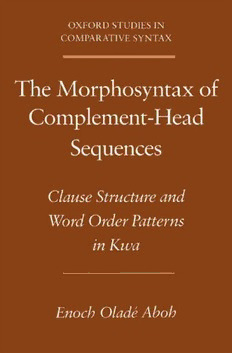
The Morphosyntax of Complement-Head Sequences: Clause Structure and Word Order Patterns in Kwa PDF
Preview The Morphosyntax of Complement-Head Sequences: Clause Structure and Word Order Patterns in Kwa
The Morphosyntax of Complement-Head Sequences Recent Titles in OXFORD STUDIES IN COMPARATIVE SYNTAX Richard Kayne, General Editor The Higher Functional Field: Evidence Subjects, Expletives, and the EPP from Northern Italian Dialects Edited by Peter Svenonius Cecilia Poletto Functional Structures in DP and IP: The Syntax of Verb-Initial Languages The Cartography of Syntactic Structur Edited by Andrew Carnie and Volume I Eithne Guilfoyle Edited by Guglielmo Cinque Parameters and Universals A Unified Theory of Verbal and Nomin Richard Kayne Projections Yoshiki Ogawa Portuguese Syntax: New Comparative Studies Syntactic Heads and Word Formation Edited by Joao Costa Marit Julien XP-Adjunction in Universal Grammar: The Syntax of Italian Dialects Scrambling and Binding in Hindi-Urdu Edited by Christina Tortora Ayesha Kidwai The Morphosyntax of Complement-Head Infinitive Constructions: A Syntactic Sequences: Clause Structure and Word Analysis of the Romance Languages Order Patterns in Kwa Guido Mensching Enoch Olade Aboh Subject Inversion in Romance and the Theory of Universal Grammar Edited by Aafke Hulk and Jean-Yves Pollock The Morphosyntax of Complement-Head Sequences Clause Structure and Word Order Patterns in Kwa Enoch Olade Aboh OXFORD UNIVERSITY PRESS 2004 OXFORD UNIVERSITY PRESS Oxford New York Auckland Bangkok Buenos Aires Cape Town Chennai Dar es Salaam Delhi Hong Kong Istanbul Karachi Kolkata Kuala Lumpur Madrid Melbourne Mexico City Mumbai Nairobi Sao Paulo Shanghai Taipei Tokyo Toronto Copyright © 2004 by Oxford University Press, Inc. Published by Oxford University Press, Inc. 198 Madison Avenue, New York, New York 10016 www.oup.com Oxford is a registered trademark of Oxford University Press All rights reserved. No part of this publication may be reproduced, stored in a retrieval system, or transmitted, in any form or by any means, electronic, mechanical, photocopying, recording, or otherwise, without the prior permission of Oxford University Press. Library of Congress Cataloging-in-Publication Data Aboh, Enoch Olade. The Morphosyntax of complement-head sequences: clause structure and word order patterns in Kwa / Enoch Olade Aboh. p. cm. Based on the author's thesis—doctoral (1998, University of Geneva). Includes bibliographical references and index. ISBN 0-19-515989-6 (cloth) — ISBN 0-19-515990-X (pbk.) 1. Kwa languages—Syntax. I. Title. PL8424 .A66 2003 496'.337—dc21 2002072346 246897531 Printed in the United States of America on acid-free paper To Marc Sessinou and Hope Assiaba This page intentionally left blank Preface This book is based on my 1998 Ph.D. dissertation (Universite de Geneve). It discusses aspects of the Gbe languages (Kwa) in the light of Kayne's (1994) universal specifier-head-complement hypothesis. In this respect, the discussion in the following chapters shows that even in a theory that assumes the directionality parameter, only an analysis in terms of the specifier-head-complement captures better the Kwa data. This renders the directionality parameter theoretically superfluous and undesirable. The discussion on the Kwa languages is therefore extended to other Niger-Congo (e.g., Mandekan, Kru) and to certain Indo-European language families (e.g., Germanic, Romance). For instance, a parallel is established between word order variations in the Gbe and Kwa languages (i.e., the OV vs. VO asymmetry) and the Germanic SOV languages. In this respect, a fine structure of the I- and C-systems suggests that word order variations result from the interaction between movement of the complement (i.e., 'object shift') and movement of the head (e.g. verb movement). On the other hand, the study of the Gbe nominal sequence and certain constructions that involve the clausal left edge leads to a clearer parallelism between D and C as two manifestations of the same system: the left periphery. D selects for a nominal sequence, that is, an articulated predicative structure that is void of finiteness, while C selects for a structure that is specified for finiteness. Most of the conclusions reached in this book would have not been possible without the help of various linguistic scholars. I'm grateful to Liliane Haegeman and Luigi Rizzi for making this work possible. I'm also greatly indebted to Houkpati B. C. Capo, Chris Collins, Rose Marie Dechaine, Cinque Guglielmo, Richard Kayne, Victor Manfredi, and Anne Zribi-Hertz for encouraging the publication of this book. My warmest thanks also go to Felix Ameka, Hans den Bensten, Anna Cardinaletti, James Essegbey, Thierry Etchegoyhen, Eric Haeberli, Severin Kinhou, Christopher Laenzlinger, Peter Muysken, Nedzad Leko, Genoveva Puskas, Lucienne Rasetti, Ur Shlonsky, Norval Smith, and Michal Starke. I apologize to any I have forgotten. I would not have been able to come to Geneva and start my research program without the help of my sisters and brothers, Jocelyne, Luc, Seth, Ines, PREFACE Alvine, Frieda, and Ethel. Thanks also to Da-Silva Urbain for believing in me. I'm also grateful to Raoul Gomez for helping. Special thanks go to Jean-Claude and Renee Dauvergne and to Veronique and Cyrille Delaye for providing a home and a second family away from home. Needless to say I owe the greatest debt of gratitude to Anne, Aniola, Femi, and Ore for loving me and opening my eyes to a new and better world, mi do kpe. Contents List of Abbreviations xi 1 Introduction 3 1.1 Purpose and organization of the book 3 1.2 Theoretical background 5 2 Outline of the Grammar of Gbe 24 2.1 On the term Gbe 24 2.2 The Gbe cluster 25 2.3 Notes on tones in the syntax of Gbe 27 2.4 Word order and clause structure 30 2.5 More on the SOV versus SVO asymmetry 52 2.6. Conclusion 75 3 The Syntax of Noun Phrases 76 3.1 The Gungbe D-system and the split-D hypothesis 79 3.2 The nominal inflectional domain 90 3.3 DP licensing and snowballing movement 101 3.4 Conclusion 114 Appendix: On the Gungbe 'Fake Postpositions' 115 4 The Syntax of Pronouns 124 4.1 Theoretical background 125 4.2 The Gungbe personal pronouns 129 4.3 Conclusion 151 5 Tense, Aspect, and Mood: The Preverbal Markers 153 5.1 Setting the stage 154 5.2 The Gungbe IP-markers 158 5.3 The Gungbe CP-markers: Conjunction ni and injuncti176 1 7 6
